Saint Martin
| Native name: <span class="nickname" ">Sint Maarten (Dutch) Saint-Martin (French) Nickname: The Friendly Island | |
|---|---|
|
| |
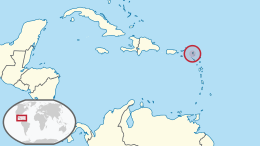 | |
| Geography | |
| Location | Caribbean Sea |
| Coordinates | 18°04′N 63°03′W / 18.067°N 63.050°WCoordinates: 18°04′N 63°03′W / 18.067°N 63.050°W |
| Archipelago | Leeward Islands, Lesser Antilles |
| Area | 87 km2 (34 sq mi) |
| Highest elevation | 414 m (1,358 ft) |
| Highest point | Pic Paradis |
| Administration | |
|
French Republic | |
| Overseas collectivity | Saint Martin |
| Capital and largest settlement | Marigot (pop. 5,700) |
| Area covered | 53 km2 (20 sq mi; 60.9%) |
|
Kingdom of the Netherlands | |
| Constituent country | Sint Maarten |
| Capital | Philipsburg |
| Largest settlement | Lower Prince's Quarter (pop. 8,123) |
| Area covered | 34 km2 (13 sq mi; 39.1%) |
| Demographics | |
| Demonym |
St. Martiner (French); St. Maartener (Dutch) |
| Population | 77,741 (January 1, 2009) |
| Pop. density | 892 /km2 (2,310 /sq mi) |
| Ethnic groups | Afro-Caribbean, Caucausian, Chinese, Indian, mixed |
Saint Martin (French: Saint-Martin; Dutch: Sint Maarten) is an island in the northeast Caribbean, approximately 300 km (190 mi) east of Puerto Rico. The 87-square-kilometre (34 sq mi) island is divided roughly 60/40 between France (53 km2, 20 sq mi)[1] and the Kingdom of the Netherlands (34 km2, 13 sq mi);[2] but the two parts are roughly equal in population, with slightly more people living on the Dutch side. It is the smallest inhabited island divided between two nations. The division dates to 1648. The southern Dutch part comprises Sint Maarten and is one of four constituent countries that form the Kingdom of the Netherlands. The northern French part comprises the Collectivité de Saint-Martin (Collectivity of St Martin) and is an overseas collectivity of France.
On 1 January 2009, the population of the whole island was 77,741 inhabitants, with 40,917 living on the Dutch side,[3] and 36,824 on the French side.[4]
Collectively, the two territories are known as "St-Martin / St Maarten". Sometimes "SXM", the IATA identifier for Princess Juliana International Airport (the island's main airport), is used to refer to the island. St. Martin (the French portion) received the ISO 3166-1 code MF in October 2007.[5] The Dutch part changed in status to a country within the Kingdom of the Netherlands in 2010 and was given the code SX.[6]
Geography

Saint Martin has a land area of 87 km2 (34 sq mi), 53 km2 (20 sq mi) of which is under the sovereignty of France,[1] and 34 km2 (13 sq mi) under the sovereignty of the Kingdom of the Netherlands.[2] This is the only land border shared by France and the Kingdom of the Netherlands anywhere on Earth, the country Sint Maarten being the sharing part of the Kingdom of the Netherlands.
The main cities are Philipsburg (Dutch side) and Marigot (French side). The Dutch side is more heavily populated. The largest settlement on the entire island is Lower Prince's Quarter, on the Dutch side.
The highest hilltop is the Pic Paradis (424 metres (1,391 ft)) in the center of a hill chain on the French side. Both sides are hilly with large mountain peaks. This forms a valley where many houses are located. There are no rivers on the island, but many dry guts. Hiking trails give access to the dry forest covering tops and slopes.
The island is located south of Anguilla, separated from the British territory by the Anguilla Channel. Saint Martin is northwest of Saint Barthélemy, separated from the French territory by the Saint-Barthélemy Channel. It is one of the Renaissance Islands.
Climate
Under the Köppen climate classification, the island has a tropical monsoon climate with a dry season from January to April and a rainy season from August to December.[7] The precipitation patterns are due to the movement of the Azores high during the year.[7] With the wind direction predominantly from the east or the northeast, temperatures remain stable throughout the year and temperatures rarely exceed 34 °C (93 °F) or fall below 20 °C (68 °F).[7] Temperatures remain steady throughout the year with an average mean temperature of 27.2 °C (81.0 °F). The average sea temperature is 27.2 °C (81.0 °F) ranging from a low of 25.9 °C (78.6 °F) in February to a high of 28.4 °C (83.1 °F) in October.[8] The total average yearly rainfall is 1,047 mm (41.2 in), with 142 days of measurable rainfall.[8] Thunderstorms can occasionally occur, with 18 days with thunder per year.[8] Precipitation totals are quite variable from year to year, depending on the number of passing tropical storms and hurricanes.
| Climate data for Saint Martin (Princess Juliana Airport) 1971–2000 | |||||||||||||
|---|---|---|---|---|---|---|---|---|---|---|---|---|---|
| Month | Jan | Feb | Mar | Apr | May | Jun | Jul | Aug | Sep | Oct | Nov | Dec | Year |
| Record high °C (°F) | 32.7 (90.9) |
31.6 (88.9) |
32.6 (90.7) |
33.6 (92.5) |
33.5 (92.3) |
33.9 (93) |
34.2 (93.6) |
35.1 (95.2) |
34.8 (94.6) |
34.3 (93.7) |
33.9 (93) |
32.1 (89.8) |
35.1 (95.2) |
| Average high °C (°F) | 28.6 (83.5) |
28.7 (83.7) |
29.2 (84.6) |
29.8 (85.6) |
30.4 (86.7) |
31.3 (88.3) |
31.6 (88.9) |
31.7 (89.1) |
31.6 (88.9) |
31.2 (88.2) |
30.2 (86.4) |
29.2 (84.6) |
30.3 (86.5) |
| Daily mean °C (°F) | 25.5 (77.9) |
25.4 (77.7) |
25.7 (78.3) |
26.5 (79.7) |
27.4 (81.3) |
28.2 (82.8) |
28.3 (82.9) |
28.6 (83.5) |
28.5 (83.3) |
28.2 (82.8) |
27.3 (81.1) |
26.1 (79) |
27.2 (81) |
| Average low °C (°F) | 23.2 (73.8) |
23.1 (73.6) |
23.5 (74.3) |
24.1 (75.4) |
25.1 (77.2) |
25.2 (77.4) |
26.1 (79) |
26.2 (79.2) |
26.0 (78.8) |
25.7 (78.3) |
24.9 (76.8) |
23.9 (75) |
24.8 (76.6) |
| Record low °C (°F) | 18.6 (65.5) |
19.2 (66.6) |
19.5 (67.1) |
19.3 (66.7) |
20.2 (68.4) |
22.3 (72.1) |
22.1 (71.8) |
21.4 (70.5) |
22.0 (71.6) |
22.1 (71.8) |
21.2 (70.2) |
20.0 (68) |
18.6 (65.5) |
| Average rainfall mm (inches) | 66.0 (2.598) |
50.7 (1.996) |
45.2 (1.78) |
64.0 (2.52) |
93.3 (3.673) |
61.8 (2.433) |
71.6 (2.819) |
98.8 (3.89) |
139.6 (5.496) |
113.0 (4.449) |
149.3 (5.878) |
93.8 (3.693) |
1,047.1 (41.224) |
| Average rainy days (≥ 1.0 mm) | 11.9 | 9.3 | 9.0 | 11.8 | 10.3 | 8.4 | 12.2 | 13.9 | 13.5 | 13.8 | 14.8 | 13.3 | 142.0 |
| Average relative humidity (%) | 74.7 | 74.1 | 73.6 | 75.0 | 75.9 | 75.1 | 74.8 | 75.4 | 76.3 | 76.8 | 77.4 | 76.6 | 75.5 |
| Mean monthly sunshine hours | 257.2 | 235.2 | 271.6 | 265.4 | 251.0 | 245.1 | 257.2 | 288.1 | 232.4 | 244.6 | 235.0 | 246.7 | 3,009.4 |
| Percent possible sunshine | 73.5 | 72.7 | 72.2 | 70.6 | 62.4 | 62.0 | 63.2 | 67.7 | 62.8 | 67.0 | 68.3 | 71.4 | 67.8 |
| Source: Meteorological Department Curaçao[8] | |||||||||||||
History
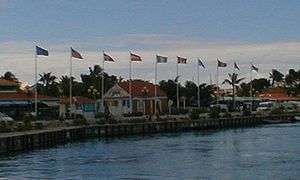
In 1493, Christopher Columbus embarked on his second voyage to the New World. According to legend, Columbus sighted and perhaps anchored at the island of Saint Martin on November 11, 1493, the feast day of Saint Martin of Tours. In his honor, Columbus named the island "San Martin". This name was translated to "Sint Maarten" (Dutch), "Saint-Martin" (French) and "Saint Martin" in English.
At Columbus' time, St. Martin was populated, if at all, by Carib amerindians. The former Arawaks had been chased by the Caribs coming from the North coast of South America a short time before the arrival of the Spaniards who followed in Columbus' wake. The Arawaks were agricultural people who fashioned pottery and whose social organization was headed by hereditary chieftains who derived their power from personal deities called zemis. The Caribs' territory was not completely conquered until the mid-17th century when most of them perished in the struggle between the French, English, Dutch, Danes and Spanish for control of the West Indies.
The Dutch first began to ply the island's ponds for salt in the 1620s. Despite the Dutch presence on the island, the Spaniards recaptured St. Martin in 1633. One year later, they built a fort (now Ft. Amsterdam) and another artillery battery at Pointe Blanche to assert their claim and control access to Great Bay salt pond. A massive influx of African slaves took place in the 18th century with the development of sugarcane plantations by the French Protestants and Dutch. Slavery was abolished in the first half of the 19th century. On some of their territories the British imported Chinese and East Indians to take the place of slaves. Thus, St. Martin and the other islands are populated by a mixture of Amerindian, European, African, Indian and Asian peoples.
On March 23, 1648, France and the Dutch Republic agreed to divide the island between their two territories, with the signing of the Treaty of Concordia. Folklore surrounds the history of the once ever-changing border division between St. Martin and Sint Maarten, and a popular story among locals narrates that "to divide the island into two sections, [in 1648] the inhabitants were told to choose two walkers, one chosen by the French-dominated community and the other one by the Dutch-dominated community, who were put back to back in one extreme of the island, making them walk in opposite directions while stuck to the littoral line, and not allowing them to run. The point where they eventually met was set as the other extreme of the island, and the subsequently created line was chosen as the frontier, dividing Saint-Martin from Sint Maarten. Seemingly, the French walker had walked more than his Dutch counterpart (each one earned his land, respectively, 54 km² and 32 km²). As the first man chose wine as his stimulant prior to the race, while the latter chose Jenever (Dutch Gin), the difference between such beverages' lightness was said to be the cause of the territorial differences by French locals, while Dutch locals tended to blame the French walker for running."[9][10]
Economy
INSEE estimated in 2005 the GDP per capita of Saint Martin for 1999 to be €14,500 (about USD15,400).[11][12]
The main industry of the island is tourism. In 2000, the island had about one million visitors annually. About 85% of the workforce was engaged in the tourist industry.[13]
Demographics
On January 1, 2009 the population of the entire island of Saint Martin was 77,741 inhabitants, 40,917 of whom lived on the Dutch side of the island,[3] and 36,824 on the French side.[4] A local dialect is spoken informally on both sides of the island.[14]
Culture and tourism
St. Martin's Dutch side is known for its festive nightlife, beaches, jewellery, drinks made with native rum-based guavaberry liquors, and casinos.[15] The island's French side is known for its nude beaches, clothes, shopping (including outdoor markets), and French and Indian Caribbean cuisine. English is the most commonly spoken language along with a local dialect. The official languages are French for Saint-Martin, and both Dutch and English for Sint Maarten. Other common languages include various French-based creoles (spoken by immigrants from other French Caribbean islands), Spanish (spoken by immigrants from the Dominican Republic and various South American countries), and Papiamento (spoken by immigrants from Aruba, Bonaire and Curaçao).
Among the leading cultural artists of the island are Youth Waves, music band; Isidore "Mighty Dow" York, kaisonian, panman; Roland Richardson, Impressionist painter; Ruby Bute, painter; Nicole de Weever, dancer and Broadway star; Lasana M. Sekou, poet, author, independence advocate; Clara Reyes, choreographer; and Tanny and The Boys, string band music group.
Public buses are the primary mode of transportation for visitors staying on the island.[16] Traffic on the island has become a major problem. Long traffic jams between Marigot, Philipsburg and the airport are common.
In recent years sargassum weed has arrived on the south ("Dutch") shoreline, but the northern French coast is generally free of the weed.[17]
Because the island is located along the intertropical convergence zone, it is occasionally threatened by tropical storm activity in the late summer and early fall.
Neighbouring islands include Saint Barthélemy (French), Anguilla (British), Saba (Dutch), Sint Eustatius "Statia" (Dutch), Saint Kitts and Nevis (independent, formerly British). With the exception of Nevis, all of these islands are easily visible on a clear day from St. Martin.
-

Simpson Bay, Sint Maarten, Dutch side
-
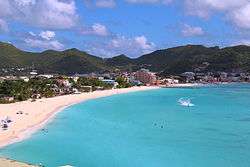
Philipsburg and the Great Bay
-
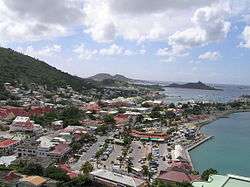
Marigot, Saint Martin, French side
Shopping
Shopping on St Maarten and Saint Martin offers duty-free goods in numerous boutiques. Popular goods include local crafts & arts, exotic foods, jewelry, liquor, tobacco, leather goods, as well as most designer goods. Most often the designer goods are offered at significant discounts, often up to 40% lower than EU retail prices.
Saint Martin uses the Euro as its currency, while Sint Maarten uses the Netherlands Antillean guilder, pegged at 2,00 per Euro. As a consequence of the dissolution of the Netherlands Antilles, the Netherlands Antillean guilder will cease to be legal tender and be replaced by the Caribbean guilder in the coming years. Almost every store on the island also accepts the United States dollar, although sometimes a more expensive exchange rate is used.
Transport
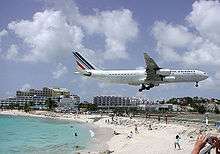
Border checks
Neither side of the island is part of the Schengen Area; full border checks are performed when travelling between the island and Europe. Passport controls are also exercised when taking the ferry from Marigot to Anguilla. There are rarely checks at the border between the two sides of the island. The Franco-Dutch treaty on Saint Martin border controls requires a working group that has never been set up, to harmonize external checks at the two main airports. The Dutch side has expressed concern that new and tighter French visa requirements would harm their tourism income.[18]
In 1994, the Kingdom of the Netherlands and France signed the Franco-Dutch treaty on Saint Martin border controls, which allows for joint Franco-Dutch border controls on so-called "risk flights". After some delay, the treaty was ratified in November 2006 in the Netherlands, and subsequently entered into force on 1 August 2007. Though the treaty is now in force, its provisions are not yet implemented as the working group specified in the treaty is not yet installed.
Airports

The island is served by many major airlines that daily bring in large jet aircraft, including Boeing 747s and Airbus A340s carrying tourists from across the world. The short main runway at Princess Juliana International Airport, and its position between a large hill and a beach, causes some spectacular approaches. Aviation photographers flock to the airport to capture pictures of large jets just a few metres above sunbathers on Maho Beach. [19]
There is a small airport on the French side of the island at Grand Case, L'Espérance Airport for small propeller planes serving neighbouring Caribbean islands. It frequently suffers thick fog during the hurricane season due to its location.
See also
- Outline of Saint Martin
- Caribbean
- Leeward Islands
- Collectivity of Saint Martin
- France
- Overseas departments and territories of France
- Région Guadeloupe et Saint Martin
- Sint Maarten
- Kingdom of the Netherlands
- Caribbean Netherlands
- List of Sint Maarten governors
- Princess Juliana International Airport
- Maho Beach
- Culture of St. Martin
- O sweet Saint-Martin's Land
- History of St. Martin
Notes
- 1 2 INSEE, Government of France. "Démographie des communes de Guadeloupe au recensement de la population de 1999" (in French). Retrieved 2009-01-27.
- 1 2 Central Bureau of Statistics Netherlands Antilles. "Area, population density and capital". Retrieved 2009-01-27.
- 1 2 Department of Statistics (STAT) of St. Maarten. "Population, St. Maarten, January 1 st" (PDF). Retrieved 2012-08-20.
- 1 2 INSEE, Government of France. "Les populations légales 2009 entrent en vigueur le 1er janvier 2012." (in French). Retrieved 2010-08-20.
- ↑ ISO 3166-1 Newsletter.Assignment of code elements for Saint-Barthélemy and Saint-Martin and update of France and other French Territories
- ↑ ISO 3166-1 Newsletter. Code elements for Bonaire, Saint Eustatius and Saba, Curaçao and Sint Maarten (Dutch part), update of other territories and minor corrections
- 1 2 3 "Climate Summaries". Meteorological Department Curaçao. Archived from the original on February 17, 2013. Retrieved February 21, 2013.
- 1 2 3 4 "Summary of Climatological Data, Period 1971-2000" (PDF). Meteorological Department Curaçao. Archived from the original (PDF) on July 2, 2013. Retrieved September 22, 2016.
- ↑ Frank Jacobs (April 24, 2012). "One Island, Two Countries". The New York Times.
- ↑ Pérez, Abón Satur (Chief Editor) (1980). Nueva Geografía Universal, Tomo IX, América. (New Universal Geography, Volume IX, America). Promexa. p. 19. ISBN 84-7113-130-7.
- ↑ Estimation du PIB de Saint-Barthélemy et de Saint-Martin, INSEE.
- ↑ World Development Indicators, World Bank. Accessed on 30 July 2012.
- ↑ "CIA Factbook". Cia.gov. Retrieved 2014-02-10.
- ↑ Holm (1989) Pidgins and Creoles, vol. 2
- ↑ "Casinos". about-saintmartin.com. 2013-06-17. Retrieved 2014-02-10.
- ↑ "Bus transit Saint-Martin". stmartinisland.org. 2015-06-22. Retrieved 2016-11-06.
- ↑ "St. Martin FAQ's". Grand Case Beach Club. 2015-08-01. Retrieved 2015-08-01.
- ↑ "Immigration Formalities". About-saintmartin.com. Retrieved 2014-02-10.
- ↑ "Aviation Photos: Philipsburg / St. Maarten - Princess Juliana (SXM / TNCM)". airliners.net.
References
- Baldachino, Godfrey (2006), "The Impact of Public Policy on Entrepreneurship: A Critical Investigation of the Protestant Ethic on a Divided Island Jurisdiction," Journal of Small Business and Entrepreneurship 19 (4), pp. 419–430.
- Dana, Leo Paul (1990), "Saint Martin/Sint Maarten: A Case Study of the Effects of Politics and Culture on Economic Development," Journal of Small Business Management XXVIII (4) October, pp. 91–98.
- Dana, Leo Paul (2010), Entrepreneurship & Religion, Cheltenham, United Kingdom: Edward Elgar, ISBN 978-1-84720-572-8.
- Houston, Lynn Marie (2005). Food Culture in the Caribbean. Greenwood Press, 2005. ISBN 0-313-32764-5.
Additional references
- Arrindell, Rhoda (2014), Language, Culture, and Identity in St. Martin. St. Martin: House of Nehesi Publishers.
- House of Nehesi Publishers Special Edition (2000), St. Martin Massive! A Snapshot of Popular Artists (2000). St. Martin: House of Nehesi Publishers
- Hyman, Yvette (2014, Fourth printing), From Yvette's Kitchen To Your Table: A Treasury of St. Martin's Traditional & Contemporary Cuisine. St. Martin: House of Nehesi Publishers
- Lake, Jr., Joseph H. (2004), Friendly Anger - The rise of the labor movement in St. Martin. St. Martin: House of Nehesi Publishers
- Sekou, Lasana M., ed. (1997, Third printing), National Symbols of St. Martin - A Primer. St. Martin: House of Nehesi Publishers.
External links
| Wikimedia Commons has media related to Saint Martin. |
- General information
- "Saint Martin". The World Factbook. Central Intelligence Agency.
- Saint Martin at DMOZ
 Wikimedia Atlas of Saint Martin
Wikimedia Atlas of Saint Martin
- News and media
- The Daily Herald daily newspaper from St. Maarten
- LE FAXinfo daily newspaper from Saint Martin (in French)
- Travel
- About Saint Martin Tourist Guide
- Dutch St. Maarten official Tourist Bureau
- French Saint Martin official Tourist Office
- French Saint Martin Hotel Association
- Princess Juliana International Airport, St. Maarten official site
 Saint Martin travel guide from Wikivoyage
Saint Martin travel guide from Wikivoyage
- Other
- Birds of St. Martin, by Eric Dubois-Millot, Action Nature







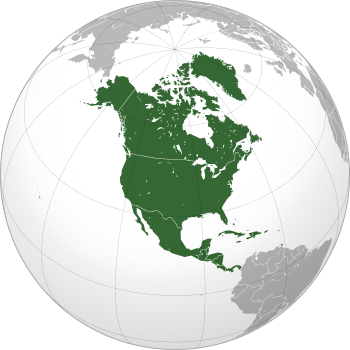
.svg.png)